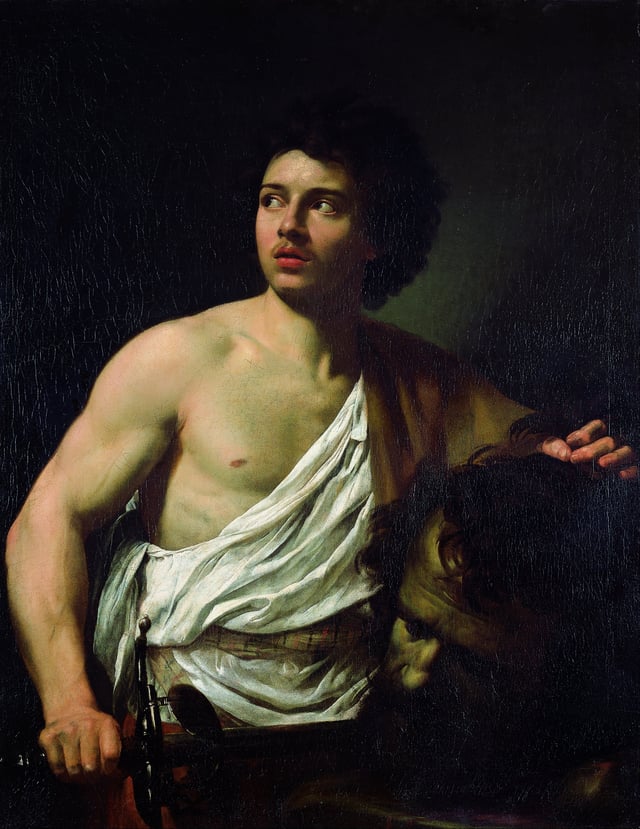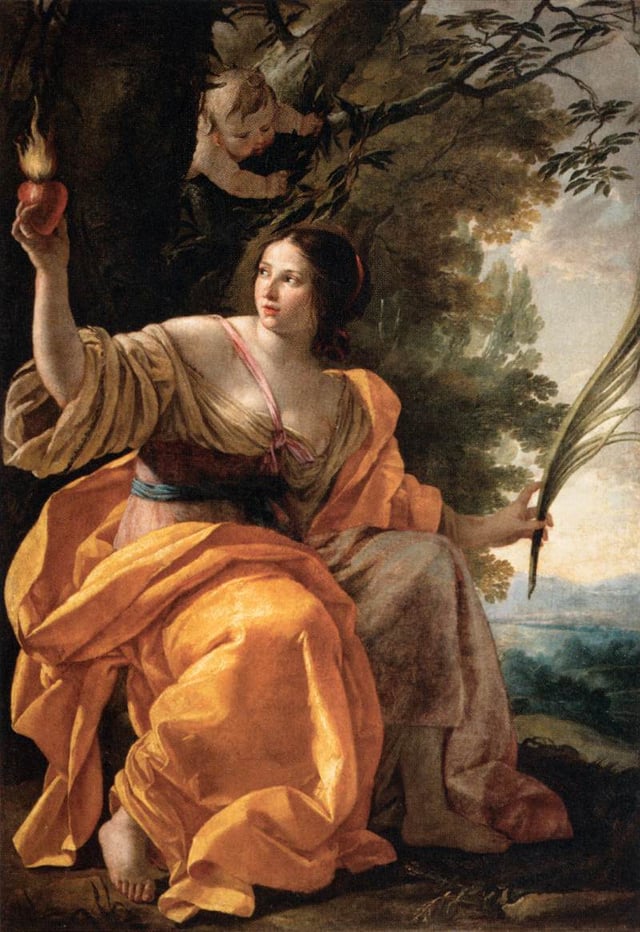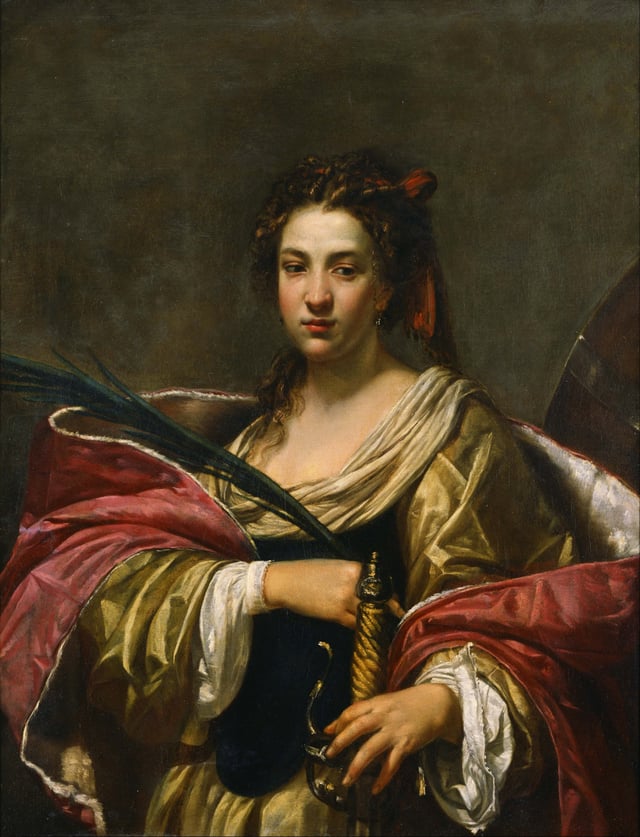Simon Vouet

Simon Vouet

Simon Vouet | |
|---|---|
| Born | (1590-01-09)9 January 1590 Paris, France |
| Died | 30 June 1649(1649-06-30)(aged 59) Paris, France |
| Education | Father's studio, stay in Rome (1613-27) |
| Known for | Painting |
| Movement | Baroque |
| Patron(s) | Louis XIII, Cardinal Richelieu |
Simon Vouet (French: [vwɛ]; 9 January 1590 – 30 June 1649) was a French painter and draftsman, who today is perhaps best remembered for helping to introduce the Italian Baroque style of painting to France.
Simon Vouet | |
|---|---|
| Born | (1590-01-09)9 January 1590 Paris, France |
| Died | 30 June 1649(1649-06-30)(aged 59) Paris, France |
| Education | Father's studio, stay in Rome (1613-27) |
| Known for | Painting |
| Movement | Baroque |
| Patron(s) | Louis XIII, Cardinal Richelieu |
Life

Vouet's allegory La Richesse was painted about 1640, possibly for one of the royal chateaux of France (Louvre)

David with the Head of Goliath

Heavenly Charity

Simon Vouet, St. Catherine
Simon Vouet was born on January 9, 1590 in Paris.[1] His father Laurent was a painter in Paris and taught him the rudiments of art. Simon's brother Aubin Vouet (1595–1641) and his grandson Ludovico Dorigny (1654–1742) were also painters.
Simon began his painting career as a portrait painter. At age 14 he travelled to England to paint a commissioned portrait and in 1611 was part of the entourage of the Baron de Sancy, French ambassador to the Ottoman Empire, for the same purpose. From Constantinople he went to Venice (1612) and was in Rome by 1614.[2] [3]
He remained in Italy until 1627, mostly in Rome where the Baroque style was becoming dominant. He received a pension from the King of France and his patrons included the Barberini family, Cassiano dal Pozzo, Paolo Giordano Orsini and Vincenzo Giustiniani.[2] He also visited other parts of Italy: Venice; Bologna, (where the Carracci family had their academy); Genoa, (where from 1620 to 1622, he worked for the Doria princes); and Naples.
He was a natural academic, who absorbed what he saw and studied, and distilled it in his painting: Caravaggio's dramatic lighting; Italian Mannerism; Paolo Veronese's color and di sotto in su or foreshortened perspective; and the art of Carracci, Guercino, Lanfranco and Guido Reni. Vouet's immense success in Rome led to his election as president of the Accademia di San Luca in 1624.[4] In 1626 he married Virginia da Vezzo who modelled Madonnas for Vouet's religious commissions.
Despite his success in Rome, Vouet suddenly returned to France in 1627, following pressing recommendations from the Duc de Béthunes and a summons from the King. A French contemporary, lacking the term "Baroque", said, "In his time the art of painting began to be practiced here in a nobler and more beautiful way than ever before," and the allegory of "Riches" [illustration, left] demonstrates a new heroic sense of volumes, a breadth and confidence without decorative mannerisms.
Vouet's new style was distinctly Italian, importing the Italian Baroque style into France. He adapted this style to the grand decorative scheme of the era of Louis XIII and Richelieu and was made premier peintre du Roi. Louis XIII commissioned portraits, tapestry cartoons and paintings from him for the Palais du Louvre, the Palais du Luxembourg and the Château de Saint-Germain-en-Laye. In 1632, he worked for Cardinal Richelieu at the Palais-Royal and the Château de Malmaison. In 1631 he also decorated the château of the président de Fourcy, at Chessy, the hôtel Bullion, the château of Marshal d'Effiat at Chilly, the hôtel of the Duc d’Aumont, the Séguier chapel, and the gallery of the Château de Wideville.
In Paris, Vouet was the fresh dominating force in French painting, producing numerous public altarpieces and allegorical decors for private patrons. Vouet's sizeable atelier or workshop produced a whole school of French painters for the following generation, and through Vouet, French Baroque painting retained a classicizing restraint from the outset (although Vouet was not as classical as his contemporaries, Nicolas Poussin and Philippe de Champaigne).
His most influential pupil was Charles le Brun, who organized all the interior decorative painting at Versailles and dictated the official style at the court of Louis XIV of France, but who jealously excluded Vouet from the Académie Royale in 1648. Vouet's other students included Valentin de Boulogne (the main figure of the French "Caravaggisti"), Charles Alphonse du Fresnoy, Pierre Mignard, Eustache Le Sueur, Nicolas Chaperon, Claude Mellan and the Flemish artist Abraham Willaerts. Also gardener André Le Nôtre, later a landscape architect, studied in his studio. Vouet was also a friend of Claude Vignon.
A number of Vouet's decorative schemes have been lost but are recorded in engravings by Claude Mellan and Michel Dorigny.[2]
Exhibitions
1990 : retrospective of Simon Vouet's work at the Galeries nationales of the Grand Palais.
2002-2003 : Simon Vouet ou l'éloquence sensible at the Musée des Beaux-Arts de Nantes (5 December 2002 – 20 February 2003), devoted to drawings from his French period now in the collection of the Staatsbibliothek in Munich.
2008-2009 : Simon Vouet, les années italiennes (1613–1627) (21 November 2008 – 23 February 2009), Musée des Beaux-Arts de Nantes,[5] in collaboration with the Musée des Beaux-Arts et d'archéologie de Besançon (where it toured 26 March to 29 June 2009).
Works
Decorative schemes
Palais de la Justice
Palais Cardinal, Musée des hommes illustre
The Châteaux de Rueil
Château de La Muette
Château-Neuf de Saint-Germain-en-Laye, The Four Cardinal Virtues
Château de Fontainebleau
Residence of Chancelier Séguier (hôtel)
Residence of Maréchal de La Meilleraye
Residence of Président Tuboeuf
Church of Saint-Nicolas-des-Champs à Paris, The Assumption (1629), Apostles at the Tomb of the Virgin
Church of Saint-Etienne à Chilly-Mazarin, Burial of Christ (1639)
Hôtel-Bullion
Church of Saint-Merry à Paris, Saint Merry releasing the Prisoners (1640)
Royal tapestries
Renaud and Armide, Renaud in the arms of Armide (1630–1660), Louvre
Moses saved from the waters (Old Testament)
The Life of Ulysses (labours of Ulysses)
Studio and copies
Saint Sebastian (1618–1620), Sarah Campbell Blaffer Foundation (USA)
Saint Peter visiting Saint Agatha in Prison, 1624
Intelligence, Memory and Will, Capitoline Museums, Rome
Virgin and Child à la rose, Musée des Beaux-Arts de Marseille
Hesselin Virgin and Child, Louvre
Sainte Marie Madeleine, National Gallery, Rome
Allegory of the Fine Arts, National Gallery, Rome
Allegory of Peace, National Gallery, Rome
Allegory of Charity (1640–1645), Museum of Draguignan
Diana, Somerset House, London
Virgin and Child with an Angel, Musée des Beaux-Arts de Caen
Suicide of Lucretia, Narodni Gallery, Prague
Roman Charity, Musée Bonnat, Bayonne
Burial, Fitzwilliam Museum, Cambridge
Martyrdom of Saint Eustace, church of Saint-Eustache, Paris
Diana, Royal Collection, Hampton Court
Hercules among the Olympians, Royal Collection, Hampton Court
Minerva, Hermitage Museum, Saint Petersburg
Virgin and Child, Hermitage Museum, Saint Petersburg
Virgin and Child, Ashmoleam Museum, Oxford
Virgin and Child, Musée Magnon, Dijon
Apollo and the Muses, National Hungarian Museum, Budapest
Salome, Crocker Art Museum, Sacramento California